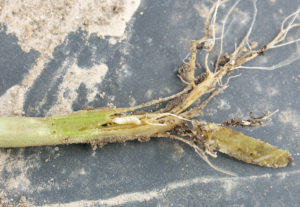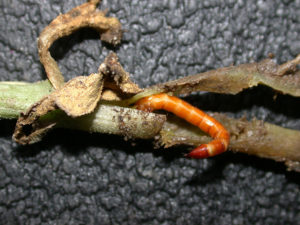In addition to delaying much of our fieldwork, the cool set spring has wreaked havoc on some of the plants we have been able to squeeze in during brief dry periods. We have received reports of damage caused by seedcorn maggots (Figure 1) and wireworms (Figure 2). In preparation of this article I browsed the Vegetable Crops Hotline archives and came across eight articles published by Rick Foster. What do they have in common? Associations with weather and limited strategies for control. Capture LFR® remains the only product labeled and for wireworms only. Rick Foster did some work with this product and had some promising results.
Seedcorn maggots typically lay their eggs in organic matter and feed on seed in the soil, however, they can also cause damage in cucurbit transplants. The adults are active in April and May laying eggs in the field. When soil temperatures reach 70°F the flies will no longer lay eggs. Black plastic mulched beds can help reduce damage in cool springs because of the increase in soil temperature. The cool, wet weather we are currently experiencing exacerbates the problem. In some cases, you may decide to replant.
Wireworms are not as common and often only appear when following corn. If you are concerned about potential wireworm infestations in a field, you need to take action prior to planting. There are effective methods of trapping the worms to monitor a field and should occur 1-4 weeks prior to planting. Soak equal amounts of untreated corn and wheat seed in water for 24 hours and then bury in a hole in the field 6 inches deep by 4 inches wide. Soaking the seed encourages germination and attracts the wireworms. Cover the bait with soil, and if possible secure black plastic over the bait to increase the soil temperature. Come back one week later and dig up the bait, look for wireworms. If present, you may want to change your planting plans and choose a crop that is less susceptible to this pest. Preplant disking or summer plowing can physically injure the insects or bring them to the soil surface where they can desiccate or be eaten. Once the field has been planted, there are no control methods available to treat cucurbits in infested fields.

